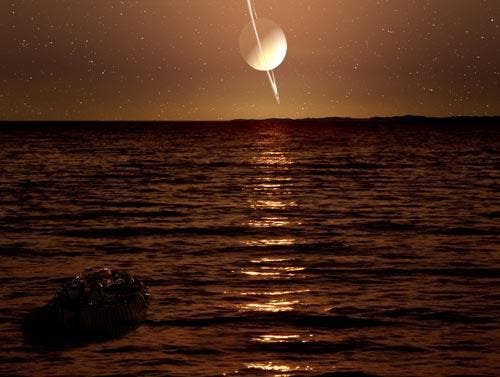At this years’ Innovative Advanced Concepts (NIAC) Symposium, NASA’s Glenn COMPASS Team discussed at large the possibility of exploring Titan, Saturn’s largest moon, with a robotic submarine that would dive deep inside the oceans of liquefied natural gas. Such a mission, if ever funded, could help answer some important questions like what are the defining chemical building blocks required to birth and sustain life. Titan is very similar to Earth in terms of cycling systems, elemental composition and terrestrial geography, so there’s much insight to be gained.
An offworld submarine


Titan is one of the few places in our solar system with stable liquids on its surface. Huge river systems, ponds, lakes and even seas can be seen throughout its surface. It also rains on Titan. But these liquids aren’t water – methane and ethane, two hydrocarbons that are usually gassy here on Earth under atmospheric conditions, comprise the bulk of liquid matter. In this strange world, freezing temperature that hovers at -179 Celsius (or -290 Fahrenheit) makes water turn to rock-hard ice and hydrocarbons into liquids. With this in mind, how could life possibly exist in this hell?
Astrobiologists believe Titan’s alien life, if it exists or ever has, needs not necessarily rely on water. Instead, the hydrocarbon soup can act as a replacing solvent.
“Think about life on Earth—we’re all either in water or we’re fancy bags of water,” says astrobiologist Kevin Hand of the Jet Propulsion Laboratory. “On Titan, life in the lakes would be ‘bags’ of liquid methane and/or ethane. That 90[Kelvin] liquid would be the solvent and then whatever is dissolved into the lakes would be the material that’s used to build the other components needed for life, and to power metabolism.”
Basically, we humans are biased in thinking life is universally and invariably based on water. The truth is, we might never know unless we start exploring other worlds. And that’s not to say that a mission to Titan’s methane deeps would only be about this – there are scores of other, let’s say more practical things we might learn from Saturn’s moon, like its tides, weather, shoreline or mysterious disappearing islands. Titan is thought to be an analog to early Earth, and studying what lies beneath the surface of Kraken Mare could well turn up some scientific surprises, like what it took for primitive life to surface on our home planet.

NASA’s Glenn COMPASS Team and researchers with the Applied Research Lab envision a submersible robot, much akin to a submarine, that would land on Titan, then start exploring its liquid methane depths. A prime target is Kraken Mare, one of the methane seas on Titan, which has been studied extensively by overlooking space probes like Cassini. There’s only so much radar can penetrate and nothing beats an on-spot probe. Yet the engineering difficulties are numerous.
“The focus for us is trying to get a vehicle that will operate in a hydrocarbon sea,” Steven Oleson of NASA’s Glenn Research Center in Cleveland said. “Think of it as liquid natural gas. How would you get a vehicle to operate in there?”
“Do you use a plutonium-powered system, or do you put a small reactor on it, or do you go non-nuclear and take some oxidizer with you? It’s a sea of natural gas, after all,” Oleson said. Some sort of gas-powered fuel cell might do the trick, he said.
The video below released by NASA seeks to explain how the robot should work and their motives. Engineers and astrologists seem to agree this challenge is worth the effort – it only remains to be seen if people in charge of the budget also think the same. It might be a while until then – the team is considering a mission launch in the 2040s, during Titan’s summer.
Read more about NASA’s plans in this PDF.


